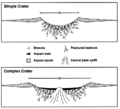(367789) 2011 AG5
 Older mid-2011 orbital solution of 2011 AG5 passing the Earth-Moon system in February 2040. Earth is the blue dot, the Moon's orbit is gray, and 2011 AG5 is green. | |
| Discovery[1] | |
|---|---|
| Discovered by |
Mt. Lemmon Survey (G96) 1.5-m reflector |
| Discovery date | 8 January 2011 |
| Designations | |
| MPC designation | (367789) 2011 AG5 |
| Minor planet category |
Apollo NEO, PHA[2] |
| Orbital characteristics[2] | |
|
Epoch 2012-Mar-14 (Uncertainty=1)[2] | |
| Aphelion | 1.989 AU (Q) |
| Perihelion | 0.8723 AU (q) |
| Semi-major axis | 1.430 AU (a) |
| Eccentricity | 0.3902 |
| Orbital period | 1.71 yr |
| Mean anomaly | 204.8° (M) |
| Inclination | 3.680° |
| Longitude of ascending node | 135.7° |
| Argument of perihelion | 53.48° |
| Physical characteristics | |
| Dimensions | ~140 meters (460 ft)[3] |
| Mass | 4×109 kg (assumed)[3] |
| Mean density | unknown |
| Absolute magnitude (H) | 21.8[2] |
|
| |
(367789) 2011 AG5 (also written 2011 AG5) is a near-Earth asteroid and potentially hazardous object.[2] It has a diameter of about 140 meters (460 ft).[3] It was removed from the Sentry Risk Table on 21 December 2012 and as such it now has a rating of 0 on the Torino Scale.[4]
It was discovered on 8 January 2011 by the Mt. Lemmon Survey at an apparent magnitude of 19.6 using a 1.52-meter (60 in) reflecting telescope.[1] Pan-STARRS precovery images from 8 November 2010 extended the observation arc to 317 days.[5] Observations by the Gemini 8.2-metre (320 in) telescope at Mauna Kea recovered the asteroid on October 20, 21 and 27, 2012,[6] and extended the observation arc to 719 days.[5] The October 2012 observations have reduced the orbit uncertainties by more than a factor of 60, meaning that the Earth's position in February 2040 no longer falls within the range of possible future paths for the asteroid.[6] On 4 February 2040 the asteroid will pass no closer than 0.006 AU (900,000 km; 560,000 mi) from Earth.[7] Until 21 December 2012 it was listed on the Sentry Risk Table with a rating on the Torino Scale of Level 1.[4] A Torino rating of 1 is a routine discovery in which a pass near the Earth is predicted that poses no unusual level of danger.[8] It is estimated that an impact would produce the equivalent of 100 megatons of TNT,[3] roughly twice that of the most powerful nuclear weapon ever detonated (Tsar Bomba). This is powerful enough to damage a region at least a hundred miles wide.
Older risks
Virtual clones of the asteroid that fit the mid-2012 uncertainty region in the known trajectory showed four potential impacts between 2040 and 2047.[3] It had a 1 in 500 chance of impacting the Earth on 5 February 2040.[3] In September 2013, there was an opportunity to make additional observations of 2011 AG5 when it came within 0.98 AU (147,000,000 km; 91,000,000 mi) of Earth.[9] The 2013 observations allowed a further refinement to the known trajectory. The asteroid will also pass 0.0121 AU (1,810,000 km; 1,120,000 mi) from the Earth on 3 February 2023.[7][10] The 2023 gravitational keyhole was 227 miles (365 kilometers) wide.[11] With a Palermo Technical Scale of -1.00,[3] the odds of impact by 2011 AG5 were about 10 times less[12] than the background hazard level of Earth impacts which is defined as the average risk posed by objects of the same size or larger over the years until the date of the potential impact.[13]
References
- ↑ 1.0 1.1 "MPEC 2011-A31 : 2011 AG5". IAU Minor Planet Center. 2011-01-09. Retrieved 2011-10-17. (K11A05G)
- ↑ 2.0 2.1 2.2 2.3 2.4 "JPL Small-Body Database Browser: (2011 AG5)". Jet Propulsion Laboratory. 2013-09-11 last obs (arc=2.84 years). Retrieved 2013-09-21.
- ↑ 3.0 3.1 3.2 3.3 3.4 3.5 3.6 "Earth Impact Risk Summary: 2011 AG5". Wayback Machine: NASA/JPL Near-Earth Object Program Office. Retrieved 2012-12-12.
- ↑ 4.0 4.1 "Date/Time Removed". NASA/JPL Near-Earth Object Program Office. Retrieved 2012-12-21.
- ↑ 5.0 5.1 "2011 AG5 Orbit". Minor Planet Center. 2011 09 21 (arc=719 days). Retrieved 2012-12-21.
- ↑ 6.0 6.1 ""All Clear" Given on Potential 2040 Impact of Asteroid 2011 AG5". NASA/JPL Near-Earth Object Program Office. December 21, 2012. Retrieved 2012-12-21.
- ↑ 7.0 7.1 "JPL Close-Approach Data: (2011 AG5)". 2013-09-11 last obs (arc=2.84 yr). Retrieved 2013-09-21.
- ↑ "The Torino Impact Hazard Scale". NASA/JPL Near-Earth Object Program Office. 13 Apr 2005. Retrieved 2011-11-05.
- ↑ "Asteroid 2011 AG5 - A Reality Check". NASA/JPL Near-Earth Object Program Office. February 28, 2012. Retrieved 2012-02-29.
- ↑ "NEODyS-2 Close Approaches for 2011AG5". Near Earth Objects - Dynamic Site. Retrieved 2013-09-21.
- ↑ "NASA Releases Workshop Data and Findings on Asteroid 2011 AG5". NASA/JPL. June 15, 2012. Retrieved 2012-06-16. (2012-178)
- ↑ Math: 101.00 = 10
- ↑ "The Palermo Technical Impact Hazard Scale". NASA/JPL Near-Earth Object Program Office. 31 Aug 2005. Retrieved 2011-10-14.
External links
- 2011AG5 at the JPL Small-Body Database
- UH Observations Result in “All Clear” for Potential Asteroid Impact (Institute for Astronomy at the University of Hawaii December 21, 2012)
- Phew! One Less Asteroid Impact to Worry About (Phil Plait Dec. 22, 2012)
- Table of next close approaches (Sormano Astronomical Observatory)
- MBPL - Minor Body Priority List (Sormano Astronomical Observatory)
| ||||||||||||||||||||||

